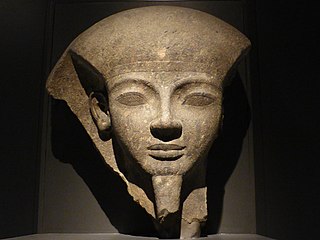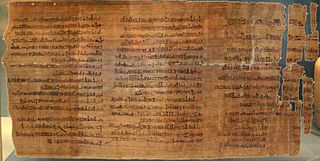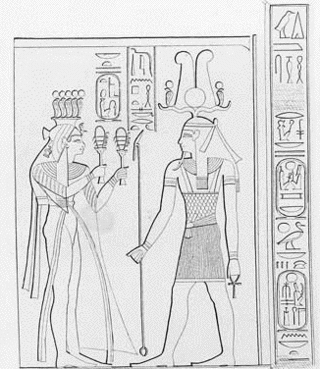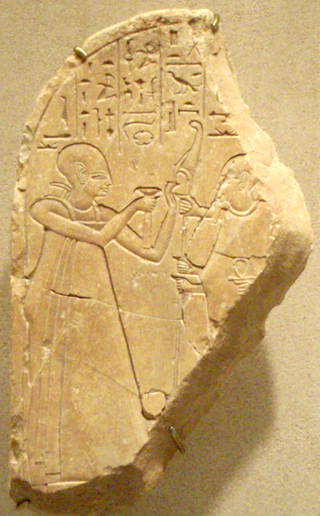
Neferkare Setepenre Ramesses IX was the eighth pharaoh of the Twentieth Dynasty of Egypt. He was the third longest serving king of this Dynasty after Ramesses III and Ramesses XI. He is now believed to have assumed the throne on I Akhet day 21 based on evidence presented by Jürgen von Beckerath in a 1984 GM article. According to the latest archaeological information, Ramesses IX died in Regnal Year 19 I Peret day 27 of his reign. Therefore, he enjoyed a reign of 18 years, 4 months and 6 days. His throne name, Neferkare Setepenre, means "Beautiful Is The Soul of Re, Chosen of Re." Ramesses IX is believed to be the son of Mentuherkhepeshef, a son of Ramesses III, since Mentuherkhopshef's wife, the lady Takhat bears the prominent title of King's Mother on the walls of tomb KV10, which she usurped and reused in the late 20th Dynasty; no other 20th Dynasty king is known to have had a mother with this name. Ramesses IX was, therefore, probably a grandson of Ramesses III.

Usermaatre Heqamaatre Setepenamun Ramesses IV was the third pharaoh of the Twentieth Dynasty of the New Kingdom of Ancient Egypt. He was the second son of Ramesses III and became crown prince when his elder brother Amenherkhepshef died aged 15 in 1164 BC, when Ramesses was only 12 years old. His promotion to crown prince:
is suggested by his appearance in a scene of the festival of Min at the Ramesses III temple at Karnak, which may have been completed by Year 22 [of his father's reign].

Menmaatre Ramesses XI reigned from 1107 BC to 1078 BC or 1077 BC and was the tenth and final pharaoh of the Twentieth Dynasty of Egypt and as such, was the last king of the New Kingdom period. He ruled Egypt for at least 29 years although some Egyptologists think he could have ruled for as long as 30. The latter figure would be up to 2 years beyond this king's highest known date of Year 10 of the Whm Mswt era or Year 28 of his reign. One scholar, Ad Thijs, has suggested that Ramesses XI could even have reigned as long as 33 years.

Ramesses VI Nebmaatre-Meryamun was the fifth ruler of the Twentieth Dynasty of Egypt. He reigned for about eight years in the mid-to-late 12th century BC and was a son of Ramesses III and queen Iset Ta-Hemdjert. As a prince, he was known as Ramesses Amunherkhepeshef and held the titles of royal scribe and cavalry general. He was succeeded by his son, Ramesses VII Itamun, whom he had fathered with queen Nubkhesbed.

Papyrus Harris I is also known as the Great Harris Papyrus and simply the Harris Papyrus. Its technical designation is Papyrus British Museum EA 9999. At 41 metres long, it is "the longest known papyrus from Egypt, with some 1,500 lines of text." It was found in a tomb near Medinet Habu, across the Nile river from Luxor, Egypt, and purchased by collector Anthony Charles Harris (1790–1869) in 1855; it entered the collection of the British Museum in 1872.
The period of ancient Egyptian history known as wehem mesut or, more commonly, Whm Mswt can be literally translated as Repetition of Births, but is usually referred to as the (Era of the) Renaissance.

Pinehesy, Panehesy or Panehasy, depending on the transliteration, was Viceroy of Kush during the reign of Ramesses XI, the last king of the Egyptian 20th Dynasty.

The Abbott Papyrus serves as an important political document concerning the tomb robberies of the Twentieth Dynasty of Egypt during the New Kingdom. It also gives insight into the scandal between the two rivals Pawero and Paser of Thebes.

Iset Ta-Hemdjert or Isis Ta-Hemdjert, simply called Isis in her tomb, was an ancient Egyptian queen of the Twentieth Dynasty; the Great Royal Wife of Ramesses III and the Royal Mother of Ramesses VI.
The Papyrus Harris 500, alt. pHarris 500 or P. British Museum 10060, contains copies of the ancient Egyptian tales of The Doomed Prince and The Taking of Joppa, of love poems and of the Harper's Song from the tomb of King Intef. The papyrus dates from the Ramesside Period.
Thomas Eric Peet was an English Egyptologist.
The ancient Egyptian document PapyrusLeopold II, is part of the original court records dealing with the tomb robberies under Ramesses IX and dates to Year 16 of Ramesses IX. It contains the confessions of eight men who had broken into the tomb of Sobekemsaf II and a description of the reconstruction of the crime. It throws light on the practices followed at ancient Egyptian courts: eliciting confessions by beating with a double rod, smiting their feet and hands, reconstructing the crime on site, and imprisonment of suspects in the gatehouse of a temple. The document remains an important document for understanding the importance of burial and the afterlife in ancient Egypt as well as crime and punishment practices in Egypt during the 20th Dynasty.

Tyti was an ancient Egyptian queen of the 20th Dynasty. A wife and sister of Ramesses III and possibly the mother of Ramesses IV.

Neferronpet was Vizier and the High Priest of Ptah from the reign of Ramesses II to the reign of Seti II.

Amenhotep was the High Priest of Amun towards the end of the Twentieth Dynasty of Egypt, serving under Ramesses IX, Ramesses X and Ramesses XI. He was the son of Ramessesnakht, the previous high priest of Amun. It is not beyond dispute who succeeded him in office. For a long time it was assumed that he was followed by the High Priest Herihor. However, Karl Jansen-Winkeln has suggested that Amenhotep was instead succeeded by the High Priest Piankh. We know the names of several of his brothers and a sister:

The Twentieth Dynasty of Egypt is the third and last dynasty of the Ancient Egyptian New Kingdom period, lasting from 1189 BC to 1077 BC. The 19th and 20th Dynasties furthermore together constitute an era known as the Ramesside period. This dynasty is generally considered to be the start of the decline of Ancient Egypt.
This page list topics related to ancient Egypt.

Khaemwaset was an ancient Egyptian vizier of the South, governor of Thebes, and possibly also High Priest of Ptah during the reign of pharaohs Ramesses IX of the 20th Dynasty.
He is mainly known for being the vizier who ordered and led the investigation into the royal tomb robberies which occurred under Ramesses IX.
Papyrus Ambras is a papyrus which was formerly in the collection of Ambras Castle near Inssbruck, and is now a part of the collection of the Vienna Museum. The first to draw attention to it was the Egyptologist Heinrich Karl Brugsch, who published about it in 1876.

Herbert Walter Fairman was a British Egyptologist. During his career he served as a field director for two excavations in Egypt that were funded by the Egypt Exploration Society.













